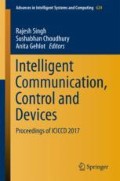Abstract
Image segmentation is a process of dividing image into smaller parts to identify the individual objects. Often, this process helps in the quantification of digital images related to disease complications for metabolic process. This work reports on the use of computer-aided modelling tools and rapid prototyping technology to document, preserve and reproduce in three dimensions, and historic machines and mechanisms are used for accurate medical diagnosis. Epidemiological and clinical trials have confirmed the greater incidence and prevalence of deaths due to the inability to acquire qualitative information from the acquisition of images in primary stage itself. Rapid prototyping gives a better understanding of clinical and physiologic mechanisms of various disorders and pain, lesion detection. In image segmentation process, thresholding method is suitable for defining optimal value for identification and detection of region of interest. The standard uptake value (SUV) is based on selecting threshold value to utilize a similarity metric between the grey level of image and data points obtained from the threshold values. This is based on the intensities or inhomogeneity of clustering framework. Affinity propagation is used for images as a matrix by measuring the square patches from similarity texture. A major challenge in computer vision is to extract this information directly from the images available to us, help users, and to see and feel as an actual part in order to bring a computer image to life. Actually, the framework is given by PET-CT images which is used to identify and detect malignant tissues in a human body with accurate measurements of SUVs. This process involves ROI identification, segmentation, rendering and SUV functional quantification for promising results. The results obtained from computer modelling are transformed into real substance by rapid prototyping technology to feel and provide accurate diagnosis to patient.
References
Brent foster, Ulas Bagci, Awais Mansoor, Ziyue Xu, Daniel J Mollura,“A Review on segmentation of Positron Emission Tomography Images”, IEEE trans. Biomedical Engineering, Vol. 1 (3), 76–96, April, 2014.
Segmentation of PET images for Computer Aided Functional Quantification of Tuberculosis in Small Animal Models” IEEE trans. Biomedical Engineering, Vol. 61(3), 711–724, Nov, 2013.
Partha Ghosh, “Reproducible Quantification in PET-CT: clinical Relevance and Technological Approaches” White paper, SIEMENS, www.Siemens.com.
Brent Foster, Ulas Bagci, Ziyue Xu, Bappaditiya Dey, Brian Luna, William Bishai, Sanjay Jain “Segmentation of PET Images for Computer—Aided Functional Quantification of Tuberculosis in Small animal models,” IEEE Trans. Biomedical Engineering, vol. 61, No.3, March 2014.
W. Sun, B. Starly, J. Nam, and A. Darling “Bio-CAD modelling its applications in Computer-aided tissue engineering”, pp. 29–47.
M. Viceconti, C. Zonnoni, and L. Pierotti. TRI2SOLID: “An application of reverse engineering methods to the creation of cad models of bone segments”. pp. 211–220.
R.A. Armistead and J.H. Stanley “Computed Tomography: A Versatile Technology.” Advanced materials & Processes 151 (2). pp. 33–36.
Sun W, Starly B, Darling A, Gomez C. “Computer-aided tissue engineering: application to biomimetic modelling and design of tissue scaffolds”, J Biotechnol Appl Biochem 39(1). pp. 49–58., 2004;
Ziaur Rahiman Shaik, D. Madhavi, N. Jyothi and Ch. Sumanth Kumar: Development of 3D Model with Iso Surface Reconstruction Algorithm in Cosmetic Surgical Applications, Pak. J. Biotechnology. Vol. 13 (special issue on Innovations in information Embedded and Communication Systems) pp. 193–198 (2016).
Ziaur Rahaman Shaik, Ch. Sumanth Kumar “A Survey on Professional CAD software for Digital fabrication of Human Head Phantom using Rapid Prototyping system” Published by International Journal of Engineering Sciences Research-IJESR Vol. 5 Dec 2015.
Brent Foster, Ulas Bagci, Brian luna, Bappaditya Dey, William Bishai, Sanjay Jain, Ziyue Xu, Daniel J Mollura,” Robust Segmentation and Accurate Target definition for PET Images using Affinity Propagation, International Symposium on Biomedical imaging, San Fransco, USA,Pg.No:1461-1464, March 2013.
Author information
Authors and Affiliations
Corresponding author
Editor information
Editors and Affiliations
Rights and permissions
Copyright information
© 2018 Springer Nature Singapore Pte Ltd.
About this paper
Cite this paper
Shaik, Z.R., Sumanth Kumar, C. (2018). A Review on Computer-Aided Modelling and Quantification of PET-CT Images for Accurate Segmentation to Bring Imagination to Life. In: Singh, R., Choudhury, S., Gehlot, A. (eds) Intelligent Communication, Control and Devices. Advances in Intelligent Systems and Computing, vol 624. Springer, Singapore. https://doi.org/10.1007/978-981-10-5903-2_17
Download citation
DOI: https://doi.org/10.1007/978-981-10-5903-2_17
Published:
Publisher Name: Springer, Singapore
Print ISBN: 978-981-10-5902-5
Online ISBN: 978-981-10-5903-2
eBook Packages: EngineeringEngineering (R0)

